Corrective suspension for dogs is a training technique used to interrupt and redirect unwanted behaviors. It involves briefly lifting the dog off the ground by the scruff of their neck, mimicking how a mother dog would discipline her pups. While this method can be effective when used correctly, it’s crucial to understand the proper technique and potential risks to avoid causing harm or fear in your dog. This article will provide a comprehensive guide to corrective suspension, covering its purpose, correct application, and important considerations for dog owners.
Understanding Corrective Suspension
Corrective suspension is rooted in canine communication. Mother dogs often use this technique to control their puppies, quickly and effectively correcting undesirable actions. When executed properly, it serves as a clear, immediate consequence for misbehavior. However, it’s important to remember that the goal is not to punish the dog but to interrupt the unwanted behavior and redirect their attention.
What behaviors can corrective suspension address? This technique can be helpful for managing behaviors like nipping, excessive barking, jumping, and pulling on the leash. It’s most effective when used in conjunction with positive reinforcement methods, such as rewarding desired behaviors.
How to Properly Administer Corrective Suspension
Proper technique is paramount when using corrective suspension. Incorrect application can cause pain, injury, or fear in your dog. Here’s a step-by-step guide:
- Timing is Key: Act immediately after the unwanted behavior occurs. Delayed correction will not be effective as your dog won’t associate the action with the consequence.
- Gentle but Firm Grip: Hold the scruff of the neck firmly but gently, just enough to lift the dog’s front paws slightly off the ground. Avoid excessive force or shaking.
- Maintain a Calm Demeanor: Your demeanor should be calm and assertive, not angry or aggressive. A harsh tone or fearful expression can frighten your dog.
- Brief Duration: The suspension should be brief, lasting only a few seconds. Prolonged suspension can be harmful and distressing.
- Immediate Redirection: After the brief suspension, immediately redirect your dog’s attention to a desired behavior. For example, if your dog nipped while playing, calmly replace your hand with a toy.
 Incorrect Corrective Suspension Technique
Incorrect Corrective Suspension Technique
When Not to Use Corrective Suspension
While corrective suspension can be a valuable tool, it’s not appropriate for all dogs or situations. Avoid using this technique with:
- Puppies under eight weeks old: Their necks are delicate and susceptible to injury.
- Very small or toy breeds: These dogs are also more prone to injury.
- Dogs with neck or spinal injuries: Corrective suspension could exacerbate existing problems.
- Fearful or anxious dogs: This technique could increase their anxiety and fear.
Alternatives to Corrective Suspension
Several alternative training methods can be just as effective as corrective suspension, without the potential risks. These include:
- Positive Reinforcement: Rewarding desired behaviors with treats, praise, or toys.
- Ignoring Unwanted Behaviors: Sometimes, simply ignoring unwanted attention-seeking behaviors can be effective.
- Interrupting and Redirecting: Use a verbal cue or a gentle touch to interrupt the unwanted behavior and then redirect your dog’s attention to a more appropriate activity.
- Time-Outs: Briefly removing your dog from the stimulating environment can help them calm down and reset.
Is Corrective Suspension Right for Your Dog?
Do you still have questions about whether corrective suspension is the right choice for your dog? Consider consulting with a certified professional dog trainer. They can assess your dog’s temperament and behavior and provide personalized guidance.
Conclusion
Corrective suspension can be an effective training tool when used correctly and judiciously. However, it’s essential to understand the proper technique, potential risks, and alternatives. Prioritizing your dog’s well-being and seeking professional guidance when needed will ensure a positive and effective training experience for both you and your furry companion.
FAQs
- Is corrective suspension cruel? When performed correctly, corrective suspension is not cruel. It mimics a natural canine communication method. However, improper application can cause pain and distress.
- Can corrective suspension injure my dog? Yes, if done incorrectly. Always use gentle pressure and avoid excessive force or shaking.
- How long should I suspend my dog? Only for a few seconds. Prolonged suspension can be harmful.
- What if my dog doesn’t respond to corrective suspension? Consider alternative training methods or consult with a professional dog trainer.
- Can I use corrective suspension on a puppy? Avoid using this technique on puppies under eight weeks old.
Further Reading on Beaut Dogs
- Positive Reinforcement Training for Dogs
- Understanding Dog Body Language
- Choosing the Right Dog Collar and Leash
Beaut Dogs is your go-to resource for all things related to dog care. We provide expert advice, helpful tips, and in-depth information on a wide range of dog breeds and their unique needs. When you need support, contact us via Email: [email protected] for detailed and accurate answers from Beaut Dogs. Visit https://beautdogs.com today to explore the wonderful world of dogs and learn how to care for them best!